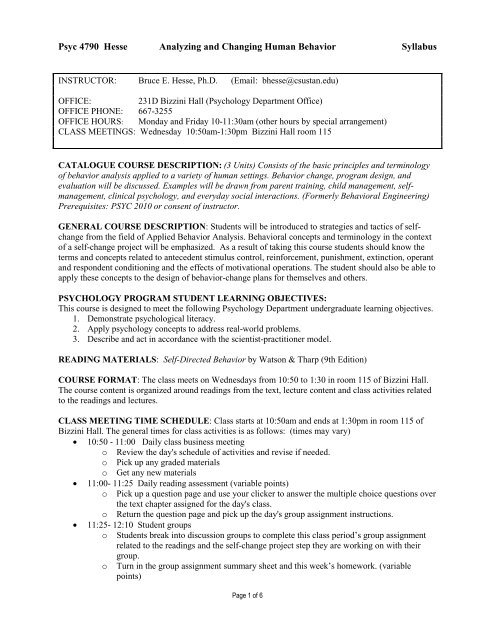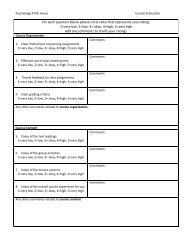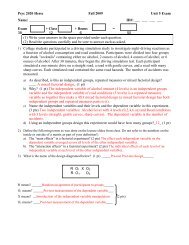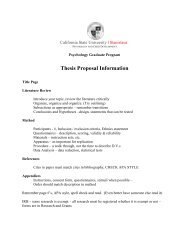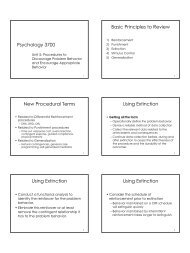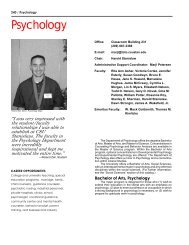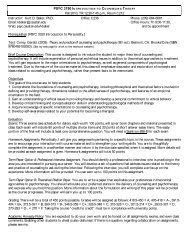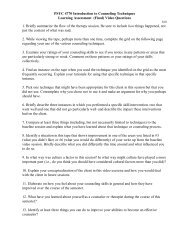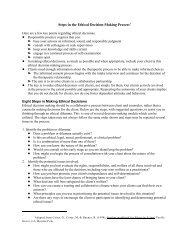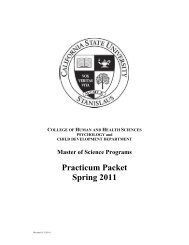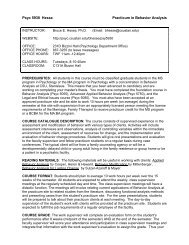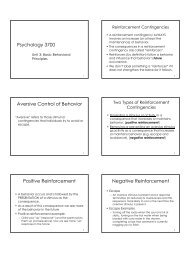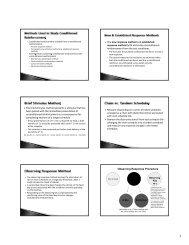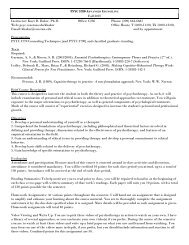Syllabus - Psychology and Child Development
Syllabus - Psychology and Child Development
Syllabus - Psychology and Child Development
Create successful ePaper yourself
Turn your PDF publications into a flip-book with our unique Google optimized e-Paper software.
Psyc 4790 Hesse Analyzing <strong>and</strong> Changing Human Behavior <strong>Syllabus</strong><br />
INSTRUCTOR: Bruce E. Hesse, Ph.D. (Email: bhesse@csustan.edu)<br />
OFFICE:<br />
231D Bizzini Hall (<strong>Psychology</strong> Department Office)<br />
OFFICE PHONE: 667-3255<br />
OFFICE HOURS: Monday <strong>and</strong> Friday 10-11:30am (other hours by special arrangement)<br />
CLASS MEETINGS: Wednesday 10:50am-1:30pm Bizzini Hall room 115<br />
CATALOGUE COURSE DESCRIPTION: (3 Units) Consists of the basic principles <strong>and</strong> terminology<br />
of behavior analysis applied to a variety of human settings. Behavior change, program design, <strong>and</strong><br />
evaluation will be discussed. Examples will be drawn from parent training, child management, selfmanagement,<br />
clinical psychology, <strong>and</strong> everyday social interactions. (Formerly Behavioral Engineering)<br />
Prerequisites: PSYC 2010 or consent of instructor.<br />
GENERAL COURSE DESCRIPTION: Students will be introduced to strategies <strong>and</strong> tactics of selfchange<br />
from the field of Applied Behavior Analysis. Behavioral concepts <strong>and</strong> terminology in the context<br />
of a self-change project will be emphasized. As a result of taking this course students should know the<br />
terms <strong>and</strong> concepts related to antecedent stimulus control, reinforcement, punishment, extinction, operant<br />
<strong>and</strong> respondent conditioning <strong>and</strong> the effects of motivational operations. The student should also be able to<br />
apply these concepts to the design of behavior-change plans for themselves <strong>and</strong> others.<br />
PSYCHOLOGY PROGRAM STUDENT LEARNING OBJECTIVES:<br />
This course is designed to meet the following <strong>Psychology</strong> Department undergraduate learning objectives.<br />
1. Demonstrate psychological literacy.<br />
2. Apply psychology concepts to address real-world problems.<br />
3. Describe <strong>and</strong> act in accordance with the scientist-practitioner model.<br />
READING MATERIALS: Self-Directed Behavior by Watson & Tharp (9th Edition)<br />
COURSE FORMAT: The class meets on Wednesdays from 10:50 to 1:30 in room 115 of Bizzini Hall.<br />
The course content is organized around readings from the text, lecture content <strong>and</strong> class activities related<br />
to the readings <strong>and</strong> lectures.<br />
CLASS MEETING TIME SCHEDULE: Class starts at 10:50am <strong>and</strong> ends at 1:30pm in room 115 of<br />
Bizzini Hall. The general times for class activities is as follows: (times may vary)<br />
10:50 - 11:00 Daily class business meeting<br />
o Review the day's schedule of activities <strong>and</strong> revise if needed.<br />
o Pick up any graded materials<br />
o Get any new materials<br />
11:00- 11:25 Daily reading assessment (variable points)<br />
o Pick up a question page <strong>and</strong> use your clicker to answer the multiple choice questions over<br />
the text chapter assigned for the day's class.<br />
o Return the question page <strong>and</strong> pick up the day's group assignment instructions.<br />
11:25- 12:10 Student groups<br />
o Students break into discussion groups to complete this class period’s group assignment<br />
related to the readings <strong>and</strong> the self-change project step they are working on with their<br />
group.<br />
o Turn in the group assignment summary sheet <strong>and</strong> this week’s homework. (variable<br />
points)<br />
Page 1 of 6
Psyc 4790 Hesse Analyzing <strong>and</strong> Changing Human Behavior <strong>Syllabus</strong><br />
<br />
<br />
<br />
12:10 - 12:25 Short class break<br />
o Students may leave for snack or restroom needs or stay in the classroom.<br />
o The class instructor will be available for brief individual consultations.<br />
12:25 - 1:25 Course content presentation <strong>and</strong> discussion<br />
o Brief oral report of the group’s products from each group’s reporter.<br />
o Lecture on new material with class participation (clicker) points. (variable points)<br />
1:25 - 1:30 Daily wrap-up<br />
o Reminders of what is required for the next class meeting.<br />
o 1:30 -- Class dismissed<br />
STUDENT ASSESSMENT: Student progress will be assessed each class period with questions over<br />
assigned readings <strong>and</strong> with graded products from activities completed in <strong>and</strong> outside of class. The<br />
questions related to the reading assessments will be multiple choice but other assessments will involve<br />
short written products. Points will be summed to determine the course grade. Please refer to the course<br />
calendar for the schedule of reading assignments <strong>and</strong> homework assignments. There usually will be 20<br />
points available for each class period. Students must purchase a student response pad <strong>and</strong> register it online<br />
(www.einstruction.com ) using the class key on the registration instructions (see last page of this<br />
syllabus). Bring your response pad to each class to earn class related grade points. Your response pad<br />
must be the Gen2 or Pulse from eInstruction <strong>and</strong> have a small LCD screen. Other types of “clickers”<br />
will not work in this class.<br />
COURSE POLICIES<br />
GRADE: The course grade is derived from the percent of points earned during the semester as follows<br />
(rounded to the nearest whole percentage point):<br />
A =90%-100% B =80%-89% C =70%-79% D =60%-69%<br />
A grade report will be available on the class web site. It will show the student's cumulative points<br />
(accessed with the last 5 digits of the student's ID number), the total points after each class, the student's<br />
average point earnings per class <strong>and</strong> the average needed from the remaining classes to get a grade of A , B<br />
or C. Summary graphs of class grade distributions will also be provided once per week.<br />
REGRADE POLICY: Students may ask for clarification <strong>and</strong>/or regrading of an assessment activity if<br />
they feel an error was made or that the points received were not representative of the quality of the<br />
product they submitted for evaluation. A regrade request involves the following:<br />
1. the reasons why the assessment should be scored differently <strong>and</strong><br />
2. references to other materials to support these reasons.<br />
3. the regrade request must be written (an oral elaboration is acceptable if the main points are noted<br />
in writing) <strong>and</strong> turned in with the assessment to be regraded.<br />
EXTRA CREDIT: Students can earn a total of 6 extra credit points in this class for the following<br />
activities:<br />
1) Participate in a research project being conducted by either a graduate or an undergraduate student<br />
who has their project registered with the online (http://csustan.sona-systems.com) <strong>Psychology</strong><br />
Department research participant pool. Each credit earned in an experiment is worth 1 extra credit<br />
points.<br />
2) Individuals who choose not to participate in a research project can earn the extra credit points by<br />
reading <strong>and</strong> summarizing an article from an APA style <strong>Psychology</strong> research journal (2 points per<br />
summary). Before doing your summary, show the abstract of the article to the course instructor for<br />
Page 2 of 6
Psyc 4790 Hesse Analyzing <strong>and</strong> Changing Human Behavior <strong>Syllabus</strong><br />
approval. Turn in your typed summary by the remedial exam date. Your summary should include the<br />
following points: (two pages maximum)<br />
a) Complete reference for the article in APA format.<br />
b) The research question or issue that this article is addressing.<br />
c) The type <strong>and</strong> number of subjects used in this research (pigeons, rats, college students, children,<br />
developmentally disabled adults, etc.)<br />
d) The general procedure & design used in the method section (e.g. surveys, direct observations,<br />
independent groups, repeated measures, etc.)<br />
e) The general results <strong>and</strong> conclusions (usually found in the first or last part of the Discussion<br />
section).<br />
ATTENDANCE <strong>and</strong> REMEDIAL EXAM: You are expected to attend <strong>and</strong> participate in each class. If<br />
you miss a class you must contact the instructor or a fellow classmate to get what you missed. Most<br />
materials (if possible) will be posted on the class website. Absence from a student assessment activity<br />
will result in a loss of points for that activity. A comprehensive remedial exam will be given during the<br />
regularly scheduled final exam time period for this class during finals week. The score earned on the<br />
remedial exam will be used to replace two missed classes. If no classes were missed the remedial exam<br />
score can be used to replace the lowest two class scores. The remedial exam is optional. If you do not<br />
wish to replace any class points you are finished with the course after the last class.<br />
Please do not ask for make-up activities, plan to take the remedial exam to replace missed class points.<br />
CHEATING POLICY: If I have good evidence of any form of academic dishonesty (not doing your<br />
own work, plagiarizing the work of others or using fraudulent means to acquire grade points) I will fail<br />
you for the course, not allow you to attend further classes <strong>and</strong> send a memo to the Dean of the College of<br />
Human <strong>and</strong> Health Sciences <strong>and</strong> the chair of your major department detailing the evidence of the cheating<br />
episode.<br />
Page 3 of 6
Psyc 4790 Hesse Analyzing <strong>and</strong> Changing Human Behavior <strong>Syllabus</strong><br />
Course Calendar<br />
Class Date Topic<br />
Chapter<br />
#<br />
Pages<br />
Project<br />
Timeline<br />
Points<br />
1 2/1 Course Introduction None None None None<br />
2 2/8 Underst<strong>and</strong>ing Behavior 1 25 Goals #1 20<br />
3 2/15 Planning for Behavior Change 2 30 Goals #2 20<br />
4 2/22 Collecting the Critical Data 3 38 Measures #3 20<br />
5 2/29 Basic Principles in Behavior Analysis 4 12<br />
6 3/7 Basic Principles in Behavior Analysis 4 13<br />
B -> C<br />
#4a<br />
A -> B -> C<br />
#4b<br />
20<br />
20<br />
7 3/14<br />
Underst<strong>and</strong>ing the Antecedents to<br />
Behavior<br />
5 25<br />
Modifying<br />
Antecedents<br />
#5<br />
20<br />
8 3/21 Self-Change Behavior 6 30<br />
9 3/28 Consequences for Change 7 35<br />
Self-change<br />
Tactics #6<br />
Self-Change<br />
Tactics #7<br />
20<br />
20<br />
10 4/4<br />
Writing a Successful Behavior Change<br />
Plan<br />
8 25<br />
Final plan<br />
with data #8<br />
20<br />
11 4/18 Modifying Behavior Change Plans 9 24<br />
12 4/25 Maintaining Behavior Change Plans 10 19<br />
Adjustments<br />
to plan #9<br />
Planning for<br />
the future #10<br />
20<br />
20<br />
13 5/2<br />
Self-Change Project Presentation & Paper<br />
Instructions<br />
None<br />
Presentation<br />
grade form<br />
20<br />
14 5/9<br />
Finish Presentations Remedial Exam<br />
Instructions<br />
Final<br />
paper<br />
due<br />
None<br />
Paper grade<br />
form<br />
20<br />
Page 4 of 6
Psyc 4790 Hesse Analyzing <strong>and</strong> Changing Human Behavior <strong>Syllabus</strong><br />
Class Name: Psyc 4790 Class Key: N71419M853<br />
You will need:<br />
Class Key (N71419M853)<br />
Connection to the Internet<br />
Method of Payment (Credit card or personal check)<br />
Enrolling through CPSOnline<br />
You will first need to setup a CPSOnline account.<br />
Create a CPSOnline Account<br />
1. Go to www.einstruction.com <strong>and</strong> click on the CPS Online Login link at the top right of<br />
the webpage or click on the picture of the response pad on the class web page (left side<br />
under response pad instructions).<br />
2. Select California State University, Stanislaus from the drop-down menu.<br />
3. Click Choose Site.<br />
4. Enter your serial number in the space provided. You can find your serial number on your<br />
LCD screen when you turn on your response pad: if your pad does not have an LCD<br />
screen, you have the wrong response pad.<br />
5. Click Create Your Account.<br />
6. Create a CPSOnline Username <strong>and</strong> Password <strong>and</strong> fill in your contact information (use the<br />
last 5 digits of your Student ID number only as your student ID). Click Submit to create<br />
your account.<br />
You’ve now created a CPSOnline account. You can use your CPSOnline username <strong>and</strong> password<br />
to login anytime to CPSOnline. Now you can enroll your pad in your class.<br />
Enroll in a Class<br />
1. Click Yes to enroll immediately in your class.<br />
2. Enter your Class Key N71419M853 in the space provided. You do not have a code so<br />
leave the code box blank.<br />
3. Click Submit <strong>and</strong> choose your payment options. Click Continue.<br />
4. Fill in your billing information <strong>and</strong> click Continue.<br />
5. To join an additional CPSOnline class, click the Enroll in a class button from the main<br />
menu.<br />
6. Once you have finished enrolling in all of your classes, click Log Out. So that<br />
CPSOnline properly records your information, log out of CPSOnline.<br />
NOTE: If you enroll in more than one class using CPS, your response pad may have a different<br />
assigned number for each class. Note your assigned response pad number after you enroll for<br />
each class, <strong>and</strong> use the reminder emails from eInstruction to keep track of your information.<br />
Page 5 of 6
Psyc 4790 Hesse Analyzing <strong>and</strong> Changing Human Behavior <strong>Syllabus</strong><br />
Using your Response Pad in your class<br />
The eInstruction response pad is easy to use with CPS. Use the information below to learn how<br />
to use the buttons on the pad. If you have any questions, log onto www.einstruction.com <strong>and</strong> use<br />
the Customer Support menu option. Type in your name <strong>and</strong> enter the live chat room for<br />
immediate help. You can also reach Technical Support at 888.333.7532.<br />
Power – turn the response pad on or off by pressing the PWR/JOIN button.<br />
Join – the response pads automatically search for a class roster to join whenever you turn<br />
on the pad.<br />
• Initiate Join – to have the response pad begin searching for a class roster to join, turn<br />
on the response pad <strong>and</strong> press the PWR/JOIN button.<br />
• Manually Join – to manually join a class, turn on the response pad <strong>and</strong> press the<br />
PWR/JOIN button twice. Join: appears on the LCD screen. Type in the channel<br />
number for the class roster you would like to join, <strong>and</strong> press Send.<br />
Use Negative Numbers – make a numeric response positive or negative by pressing the<br />
+- button.<br />
Enter Equations – create equations by entering symbols into your response with the<br />
Sym button. You can include the following symbols: X, Y, =, ( ), . (decimal), + (plus<br />
operator), - (minus operator), / (division operator), * (multiplication operator), (space)<br />
View Response Pad Information – to view the response pad channel, roster number,<br />
<strong>and</strong> firmware version, turn the pad on <strong>and</strong> press the < button.<br />
View Serial Number – to view the serial number for your response pad, simply press the<br />
PWR/Join button to turn on the response pad. The serial number displays in the LCD<br />
screen as your response pad searches for a class roster to join. Your serial number will<br />
begin with “r1…”.<br />
Adjust LCD Screen Contrast – to adjust the LCD screen contrast, press the > button.<br />
Use the A1 button to decrease the contrast <strong>and</strong> the C3 button to increase contrast.<br />
Page 6 of 6


